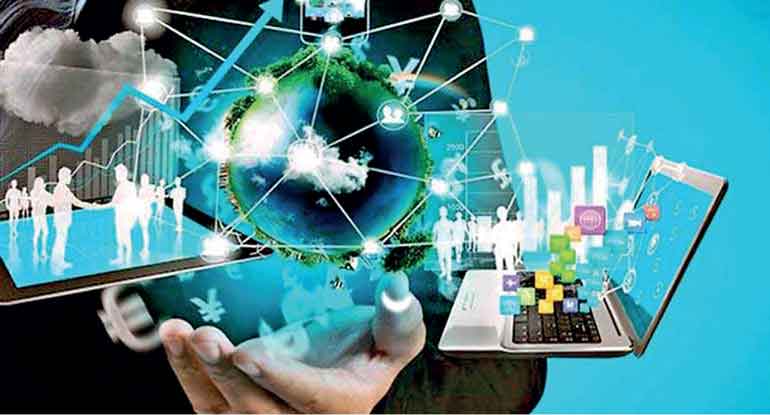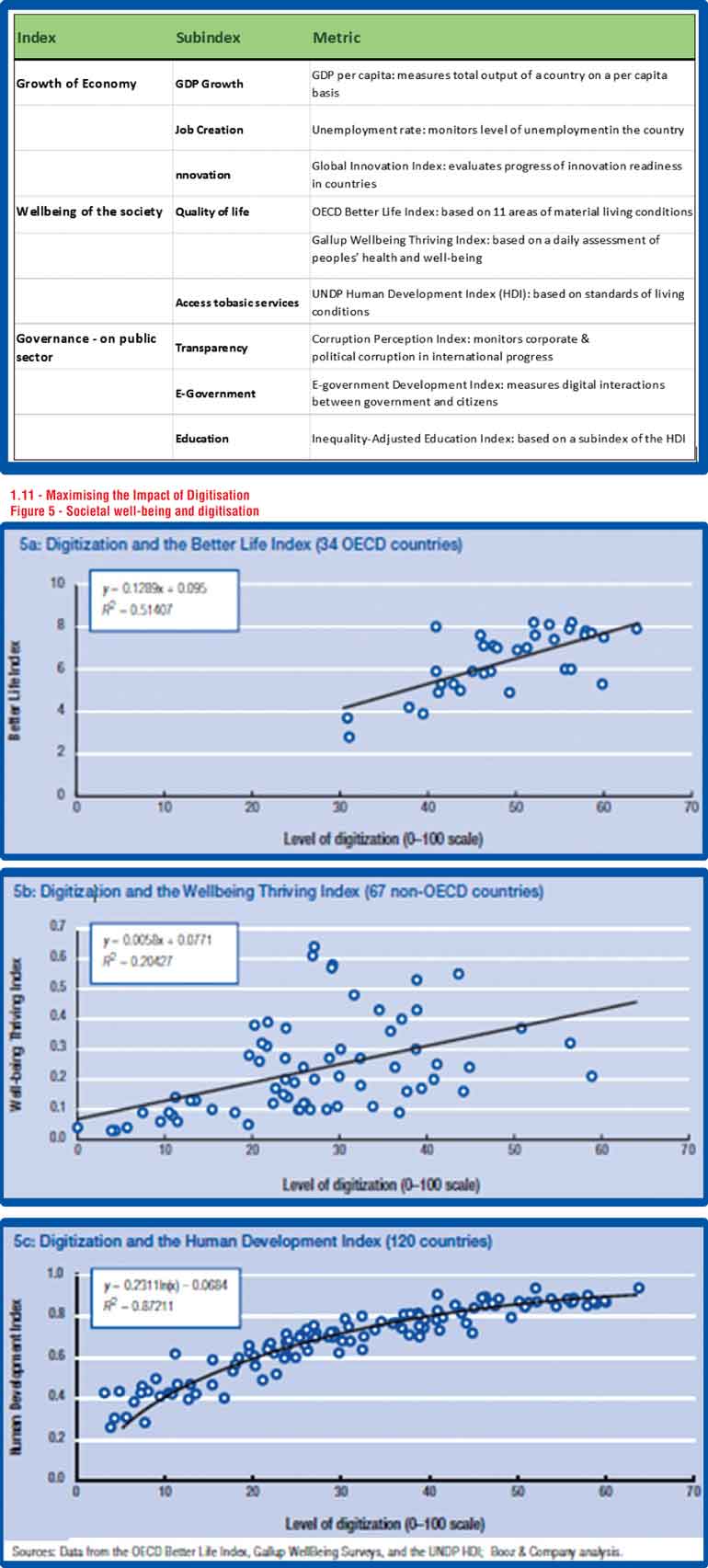Saturday Feb 08, 2025
Saturday Feb 08, 2025
Saturday, 8 February 2025 00:01 - - {{hitsCtrl.values.hits}}

To derive full benefits for the SOE sector, the Government needs to look at a holistic view of interconnecting systems that were built and operated by individual agencies and the level of current usage
 Preface
Preface
Digital economy is often being spoken in various forums to improve the productivity and efficiency thus curbing inefficiencies and corruption, especially in the public sector organisations. The urgency of the Government is to take progressive action to end paper-based systems that had been the centre for manipulation of records, misconduct and mismanagement. To date no Government had the will to execute an integrated digitisation program despite promises. The plan should account for a holistic approach not limiting to one technical area of digitisation or digitalisation.
Transition to digitisation
In the past, four decades ago, inter and intra government agencies communications were paper-based, either carried by the peons or by post. The reports/communique were handwritten or dictated to the stenographers-typists and typesetting on manual typewriters. Due to likelihood of mistyping, amendments and corrections had to be made multiple instances at the expense of hours of the writer and the typist. With the introduction of electric typewriters, the process became somewhat easier and efficient comparatively. Standalone computers were introduced on selective basis in State sector organisations with minimal word processing capabilities thus further enhancing the process.
Reports prepared were sent by post and lately over facsimile, depending upon the availability at both originating and receiving ends. The real revolution began in 1990s upon the availability of internet and adapting e-mails for communications. The internet at early stage was not developed as of today to cater traffic volumes. The mass scale digitisation was kicked-in to address issues encountered and experienced over the past several years. Thanks to the proliferation of technology and its rapid developments.
Digitisation
Digitisation is the process of converting information from a physical format, basically analogue form into a digital one. In the early stages the transformation process targeted refreshing analogue links carrying information from one point to the desired destination. The development of encoders and decoders further enhanced conversion to digital format and interconnect and interface computers and other mobile devices.
Digital transformation and digitalisation
In a nutshell, digital transformation is another word that is often interchangeably being used alongside digitisation and digitalisation. Fundamentally, digital transformation is the outcome of the process of digitalisation which opens a plethora of features that are available to make business processes efficient. In the context of Sri Lanka, there had always been delays in progressing with digitisation due to potential resistance to change by trade union actions and other lobby groups appearing for employee rights highlighting the risks of losing employment. It is evident that once manual functions are transferred to technology platforms there will be redundancies. Henceforth, the Government needs to manage this uprising by offering handsome redundancy packages and retraining able staff to carry out such functions. Could Sri Lanka sustain corrupt practices to continue or keep pace with the developing world? I believe the current Government has least hurdles to overcome and will manage successfully.
Digital integration
To derive full benefits for the SOE sector, the Government needs to look at a holistic view of interconnecting systems that were built and operated by individual agencies and the level of current usage. The core requirements of interconnection are to carry traffic and sharing of data across the SOEs for common good but with restriction limiting access as per the functions of the individual SOE.
The backbone and the spur networks for transporting and access across SOE need to cater for the current and future traffic flows. Leasing option for such services from the local service providers to be considered rather than State building and maintaining networks. Leasing option is well proven as efficient, reliable and high availability in the developed world.
In addition to transport networks, a critical aspect is the data storage and accessibility when needed. Countries build storage farm with geographical diversity and additionally subscribe for Cloud storage which are gaining popularity and cost effective. Whatever the facilities built, the cyber security and data encryption is most important to block intruders’ access thus destroying the systems. Build relational databases structure, differentiate Metadata v Detailed data, precluding unauthorised access despite being employees.
Employee access rights, another important area where access to data be given based on job function of individuals thus increased further level of security also remote access facilities. System access should be built with multi-level of authentication as enhancements.
The story created much interest in the past few months was the disappearance of critical records of medicines in the NMRA database. If the individual access rights were employed at system commissioning, the culprit could have been easily identified. It also appears that there were no duplicate storage sites/facilities with geographical diversity. Backing up, uploading and archiving policy of data also need to be carefully planned covering the requirements and sensitivity of the entire system.
Upgrading existing digital paraphernalia and refreshing with commercial-scale quantum computers, deployment of Digital ID System, and promoting responsible AI initiatives will need to be taken care for future plan and development to fully embracing digital transformation and reap the benefits to maximum. Technology and technology partners, their ulterior motives should be a critical and core factor when selecting partners or vendors prevent future and unknown surprises. Testing regimes should be comprehensive, strong and cater for detecting snags, issues, rectify and to reject in the event noncompliance. Supply, delivery and commissioning clauses have to be well defined in the contractual agreement and for ongoing maintenance contracts.
Components of digitisation success
Although politicians frequently talk of digitalisation “”, majority have a shallow understanding of the total end to end challenges to go through. Following aspects need focus and attention:
Assessment: Thorough assessment of where Sri Lanka currently in, in terms of networks, IT systems, availability of local technical resources, potential issues and commitment;
Service spread: The extent of coverage to consumers and enterprises for accessing to universal and digital services. Ongoing planning and cater for growth of the digital services based on demand is essential;
Affordability: Extent to which digital services are priced in a range that makes them available to as many people as possible;
Reliability: Service quality and availability – minimise unplanned service interruptions, building redundancy;
Data-rates: Guaranteed offering of data rates in Mbps differentiating, peak, shoulder and off-peak periods;
Usability: Ease of use for digital services and the ability of local ecosystems to boost adoption of these services; and
Skills: Ability of users to incorporate digital services into their lives and businesses. It is also, important human resources, with fully trained personals for successful operations of digital services and service maintenance in ICT-T space and data analytics.
Operational success requires to define and monitor set of KPI (Key Performance Indicators) for quality service delivery (a) the extent to which ICT is being assimilated in societies. (b) Devise tools to determine the impact that the adoption of connected digital technologies and applications are having on societies and economies. (c) As highlighted previously the policymakers to establish rules to enhance access to communication services—setting policies that introduce competition and promote infrastructure sharing among the service providers.
Towards utopia
Policymakers today face multiple challenges in the Information and Communication Technology and Telecommunication (ICT-T) space to expedite the implementation of digitisation rightly tailored for current and future requirements to derive maximum economic benefits. The widespread usage of digital paraphernalia, ubiquitous, makes exponential growth in global data communication demands optimal operations and efficient use of networks and applications by agencies and individuals. The nations that are in the advanced stage of developed have agility to adopt changes have especially, benefited the economy achieving high productivity with less room for corruption.
Sri Lanka being an emerging State in terms of ICT-T, one could reasonably assume that access affordability has been moderately addressed. However, there are still pockets of unserved areas, viz: inadequate coverage and marginal use of technology primarily due to high cost of digital paraphernalia. During COVID-19, we had witnessed students climbing trees to get coverage for their online studies. Furthermore, an efficient national IXP (Internet exchange point) to route data traffic without time lags as opposed to improve access coverage, service reliability and availability. It is also of the view that service reliability is below par of emerging nations compared to transitional subclass of nations where reliability, extent of service coverage affordability, digital equipment and service had been addressed and being improved.
The framework for measuring digitisation’s socioeconomic impact
The given table depicts the expected areas of improvements as a result of digitisation. Depending upon the stage of digitisation a country is in, the benefits may vary. At least Sri Lanka needs to target by 2030 to a competitive force in terms of trade in the South Asian Region. A plan without a target and will, will never be achieved.
The effect of digitisation needs to be assessed on as per the list of indexes of Table (a) viz: economy, societal well-being and governance. Some examples of achievements of Australia, being a country in the advanced stage of digitisation are depicted below as a guide.
Digitisation has led to improved governance in Australia through the development of digital strategies and the use of digital tools.
Economic benefits have been estimated to reach A$ 56.7 billion per annum by 2030. This will see continued demand for Australia’s technology workforce. The technology sector is the seventh-biggest employing sector in Australia.
Assessing based on available data, Australia performs well in many dimensions of well-being index relative to other advanced countries. Australia also outperforms the average in income, jobs, education, health, environmental quality, social connections, civic engagement and life satisfaction.
Explanatory graphs
The given graphs show the stages of digitisation selected OECD countries were at, in terms of Better life index (fig: 5a), Well-being Thriving index (fig: 5b) and Human Development (fig: 5c) in their respective development captured in 2012. Noticeably, the Well-Being graph is scattered and Human Development graph fits very closely to the predicted curve. Assessing well-being of societies is complicated and, in the absence of universal metric that act as a barometer of societal advancement being the reason for random data spread.
Conclusion
Currently, Sri Lanka is strongly focusing on developing economy and its digital policies. However, it appears that the contribution of technology is seldom spoken of and is unfortunate. The role and the contribution of engineers to the society and economy have been unacknowledged. I believe this is one cause of destruction. I believe the Government will establish a parliamentary select “Committee on Deployment of Technology in SOEs” (CODT) to scrutinise end to end process and deployment of all ventures, current and future. To bring the transformation to a state of near utopia, is an uphill battle which require specialised technical resources and funding.
Achieving an advanced state is progressive exercise with proper planning and execution. Despite Sri Lanka having progressed to an emerging state, in the scale of two out of four viz: constrained, emerging and transitional and advanced, and reaping benefits to impact SOE governance require integration of SOE systems, sharing information and data, storage and periodically archiving data.
Continued investment in the digital economy and initiatives like building commercial-scale quantum computers, expanding the Digital ID System, QR codes and promoting responsible AI is the perfect time for businesses to embrace digital transformation. While implementation, precautions and correct level of safeguards need to be incorporated to secure privacy of citizens. In China such implementation has been criticised of invading privacy of people who criticise CCP despite heavy criticism from the West. Sri Lanka needs to be vigilant while purchasing technology of such countries that may create issues overtime.
Take away from Australian Government strategy: The Australian Government’s Data and Digital Government Strategy sets out a vision for delivering digital public services by 2030. This has been developed through extensive consultations with the community, industry, and government. Sri Lanka too needs to focus on this path through consultation with the stakeholders and prepare a comprehensive integrated digitisation plan and execute with strict project management.
To end, a famous historian and a scientist had alarmed that unethical application of AI technology may redefine humans as ‘not mysterious souls’ anymore, but hackable animals, once hacked easily be engineered without being aware!
References:
https://www.semanticscholar.org/paper/Maximizing-the-Impact-of-Digitization-Sabbagh-Friedrich/46fc25d5487437a6da4382ae2b59320f3a72a65a
https://www.unsw.edu.au/newsroom/news/2024/08/whats-inflation-how-exactly-measure
https:/dfat.gov.au
https://www.oecdbetterlifeindex.org/countries/australia/
https://www.ft.lk/columns/Artificial-Intelligence-and-its-applications/4-748882

Discover Kapruka, the leading online shopping platform in Sri Lanka, where you can conveniently send Gifts and Flowers to your loved ones for any event including Valentine ’s Day. Explore a wide range of popular Shopping Categories on Kapruka, including Toys, Groceries, Electronics, Birthday Cakes, Fruits, Chocolates, Flower Bouquets, Clothing, Watches, Lingerie, Gift Sets and Jewellery. Also if you’re interested in selling with Kapruka, Partner Central by Kapruka is the best solution to start with. Moreover, through Kapruka Global Shop, you can also enjoy the convenience of purchasing products from renowned platforms like Amazon and eBay and have them delivered to Sri Lanka.
Discover Kapruka, the leading online shopping platform in Sri Lanka, where you can conveniently send Gifts and Flowers to your loved ones for any event including Valentine ’s Day. Explore a wide range of popular Shopping Categories on Kapruka, including Toys, Groceries, Electronics, Birthday Cakes, Fruits, Chocolates, Flower Bouquets, Clothing, Watches, Lingerie, Gift Sets and Jewellery. Also if you’re interested in selling with Kapruka, Partner Central by Kapruka is the best solution to start with. Moreover, through Kapruka Global Shop, you can also enjoy the convenience of purchasing products from renowned platforms like Amazon and eBay and have them delivered to Sri Lanka.